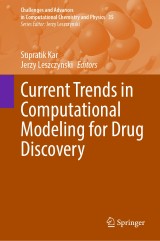Details

Current Trends in Computational Modeling for Drug Discovery
Challenges and Advances in Computational Chemistry and Physics, Band 35
|
CHF 271.50 |
|
| Verlag: | Springer |
| Format: | |
| Veröffentl.: | 30.06.2023 |
| ISBN/EAN: | 9783031338717 |
| Sprache: | englisch |
Dieses eBook enthält ein Wasserzeichen.
Beschreibungen
<div>This contributed volume offers a comprehensive discussion on how to design and discover pharmaceuticals using computational modeling techniques. The different chapters deal with the classical and most advanced techniques, theories, protocols, databases, and tools employed in computer-aided drug design (CADD) covering diverse therapeutic classes. Multiple components of Structure-Based Drug Discovery (SBDD) along with its workflow and associated challenges are presented while potential leads for Alzheimer’s disease (AD), antiviral agents, anti-human immunodeficiency virus (HIV) drugs, and leads for Severe Fever with Thrombocytopenia Syndrome Virus (SFTSV) disease are discussed in detail. Computational toxicological aspects in drug design and discovery, screening adverse effects, and existing or future in silico tools are highlighted, while a novel in silico tool, RASAR, which can be a major technique for small to big datasets when not much experimental data are present, is presented. The book also introduces the reader to the major drug databases covering drug molecules, chemicals, therapeutic targets, metabolomics, and peptides, which are great resources for drug discovery employing drug repurposing, high throughput, and virtual screening. This volume is a great tool for graduates, researchers, academics, and industrial scientists working in the fields of cheminformatics, bioinformatics, computational biology, and chemistry.<br></div>
SBDD and its challenges.- In silico discovery of class IIb HDAC inhibitors: The state of art.- Role of computational modelling in drug discovery for Alzheimer’s disease.- Computational Modeling in the Development of Antiviral Agents.- Targeted computational approaches to identify potential inhibitors for Nipah virus.- Role of Computational Modelling in Drug Discovery for HIV.- Recent insight of the emerging severe fever with thrombocytopenia syndrome virus: drug discovery, therapeutic options, and limitations.- Computational toxicological aspects in drug design and discovery, screening adverse effects.- Read-Across and RASAR tools from the DTC Laboratory.- Databases for Drug Discovery and Development.
<div><div><div><b>Dr. Supratik Kar</b>, Tenure Track Assistant Professor in the Department of Chemistry at Kean University, Union, New Jersey, USA. Dr. Kar had listed in the "Top 2% Scientists in the World for singleyr_2020" considering all research fields published as per August 2021 data-update for "Updated science-wide author databases of standardized citation indicators". He has completed his B. Pharm. (2008) and M. Pharm. (2010) degrees from Jadavpur University, India securing the first position in both degrees and earned his Ph.D. (2015) from Jadavpur University, India. He is a former visiting researcher at the University of Gdańsk, Poland under a Marie-Curie research fellowship. Dr. Kar also worked as a post-doctoral research associate (2015-2022) at Jackson State University, Mississippi, USA. He has experience in computer aided drug design, molecular modeling and the field of medicinal chemistry for over thirteen years. He has published 86 (50+ Q1 and Q2 Journals) research andreview articles in peer-reviewed journals, 23 book chapters, and co-authored two QSAR related books and Edited 1 book for Springer. Dr. Kar’s work has been cited 5600+ times according to Google Scholar with an h-index of 38. He serves as an associate editor for the Molecular Diversity (Springer), Frontiers in Pharmacology (Frontiers) and IJQSPR (IGI-Global). He is also serving as an Editorial Board member of the Journal of Clinical Medicine (MDPI), Current Drug Metabolism (Bentham), Pharmacogenomics Research and Personalized Medicine (AME) and IJANR (IGI-Global). He is also reviewer board member for Polymers (MDPI) and Informatics and Computational Methods [Frontiers in Natural Products] (Frontiers). Dr. Kar worked as a reviewer and an editor for 70+ reputed peer-reviewed journals.</div><div><b><br></b></div><div><b>Dr. Jerzy Leszczynski,</b> Professor of Chemistry and President’s Distinguished Fellow at the Jackson State University (JSU). Prof. Leszczynski attended the Technical University of Wroclaw (TUW) in Wroclaw, Poland obtaining his M.S (1972) and Ph.D. (1975) degrees. He directs the NSF Interdisciplinary Nanotoxicity CREST Center. Dr Leszczynski has served as a referee for over 50 journals and has published over 1150 referred papers and over 80 book chapters and has served as an editor of over 55 books. He has given about 1000 presentations, with over 250 of those being invited presentations. His papers have been cited about 40000 times and his Hirsh index amounts to 95. He is the recipient of the White House Millennium Award for Teaching and Research Excellence in Mathematics, Science, and Engineering apart from several other international awards. Prof. Jerzy had listed in the "Top 2% Scientists in the World for single year consecutively for last 4 years considering all research fields published as per "Updated science-wide author databases of standardized citation indicators"”</div></div></div>
This contributed volume offers a comprehensive discussion on how to design and discover pharmaceuticals using computational modeling techniques. The different chapters deal with the classical and most advanced techniques, theories, protocols, databases, and tools employed in computer-aided drug design (CADD) covering diverse therapeutic classes. Multiple components of Structure-Based Drug Discovery (SBDD) along with its workflow and associated challenges are presented while potential leads for Alzheimer’s disease (AD), antiviral agents, anti-human immunodeficiency virus (HIV) drugs, and leads for Severe Fever with Thrombocytopenia Syndrome Virus (SFTSV) disease are discussed in detail. Computational toxicological aspects in drug design and discovery, screening adverse effects, and existing or future in silico tools are highlighted, while a novel in silico tool, RASAR, which can be a major technique for small to big datasets when not much experimental data are present, is presented. Thebook also introduces the reader to the major drug databases covering drug molecules, chemicals, therapeutic targets, metabolomics, and peptides, which are great resources for drug discovery employing drug repurposing, high throughput, and virtual screening. This volume is a great tool for graduates, researchers, academics, and industrial scientists working in the fields of cheminformatics, bioinformatics, computational biology, and chemistry.
Discusses fundamental tools, algorithms and methods of computational modeling Presents applications of molecular modeling to drug design Features contributions from leading experts in the field

















